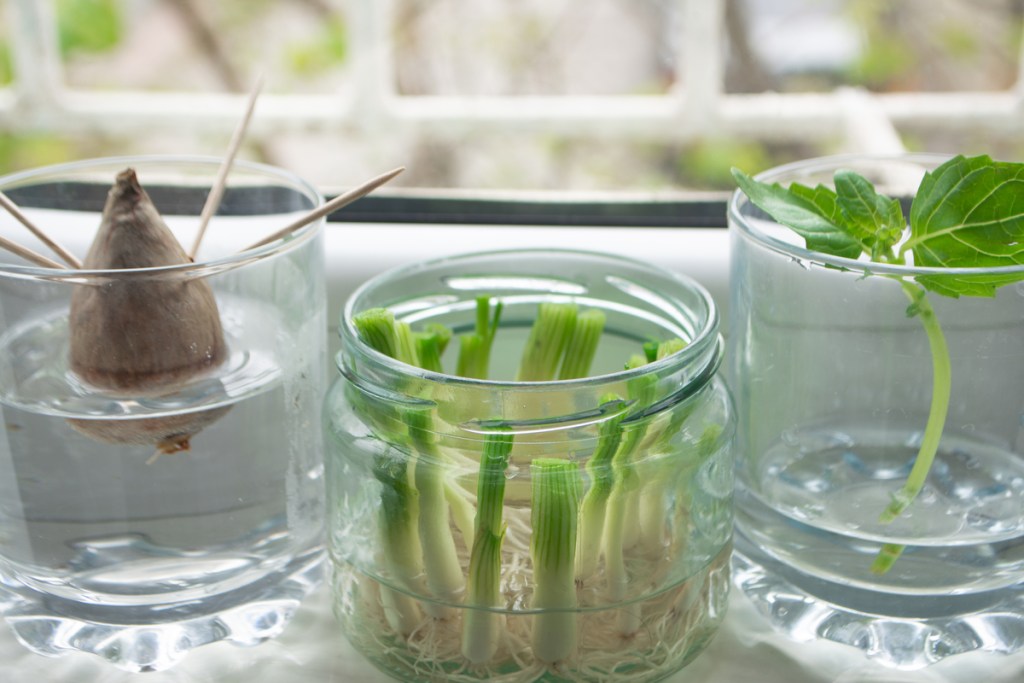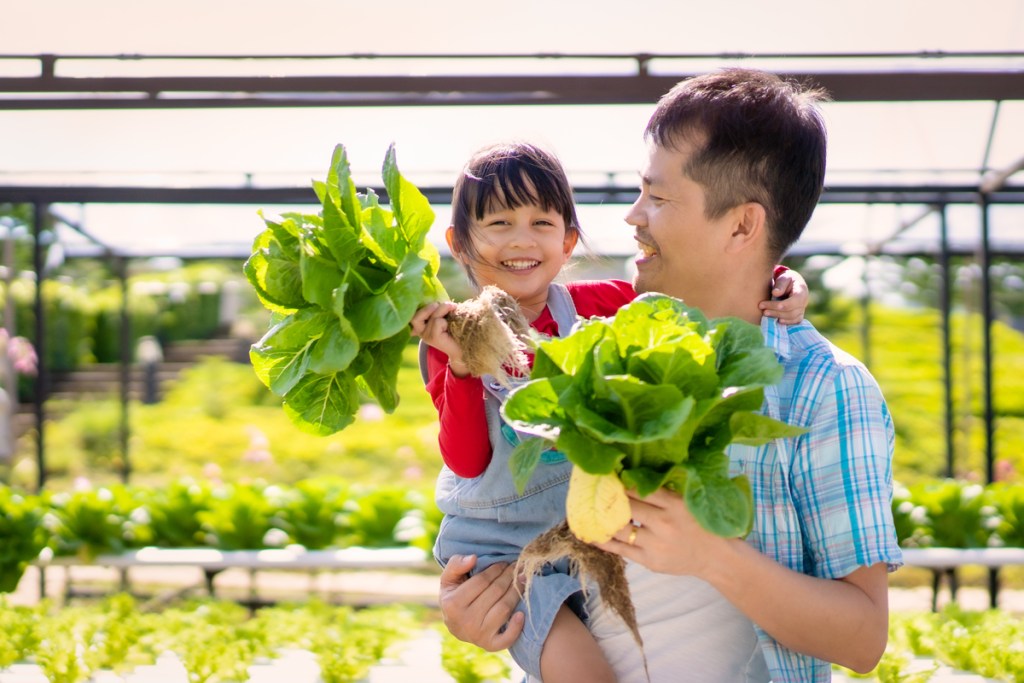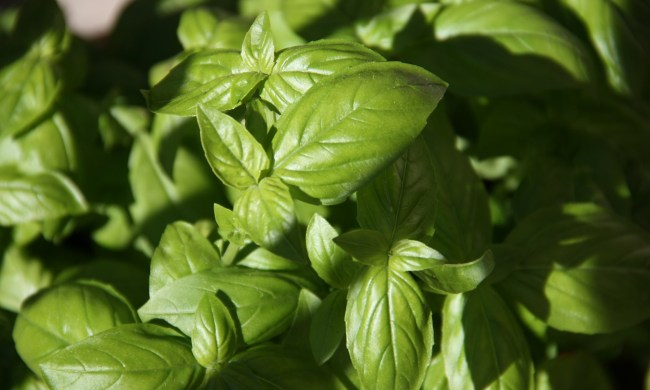Believe it or not, some of your kitchen scraps have use beyond the compost heap! There are some fruits and vegetables that can be regrown—not to what they were before, but enough to get another use or two out of new sprouts. Scrap gardening is a great way to bring your kids into the world of nature, share your love of gardening, and teach them the rewards of growing plants.

What is scrap gardening?
Scrap gardening is mildly self-explanatory. It involves taking the scraps from your kitchen (usually the inedible parts of the food that typically get thrown away) and planting them to grow something new. This is often done indoors but can be done outdoors in warmer months and in hardiness zones with warmer climates. When doing it outdoors, you can either scrap garden in containers or make a small designated garden box.
For parents who are looking to introduce their kids to gardening, or get them involved in a fun outdoor summer activity, this method is a go-to! Not only will they watch you repurpose the bottom piece of lettuce that’s normally thrown out, they’ll also get to grow and care for something alongside someone they love (hint: that’s you!).
Getting the kids involved
One of the best feelings for a parent who gardens is getting to share their love of nature and plants with their children. So, let’s do some scrap gardening kids can take part in! Almost any child will enjoy the responsibility and independence that comes with taking care of their own plants, and scrap gardening is low-risk. Because you’re taking something that would otherwise get thrown away, you won’t have to worry about all the new plants you purchased at the nursery going without care. If your kid forgets to water the scraps for a day, it becomes a lesson in how important it is to provide proper care.
Scrap gardening gives you the opportunity to bond with your child while teaching them about how nature works. They’ll get to see first hand how things can grow and flourish if we care for them as best we can (and in this digital age, it’s a great way to get them off the couch and out in the sun). Because you’ll most likely be scrap gardening outdoors in the summer, it’s also a great way to keep their minds active while they have time off from school.
If you opt for the small outdoor garden box, your kid will love having their own garden to take care of. They can even make a little sign with their name (for example, Abi’s Garden or Cailey’s Cuttings) to personalize it. Having a project where your child feels like it’s their own not only helps encourage their learning, but it lets them have fun, too!

Best foods for scrap gardening
Not every food will be good for scrap gardening. Some of the best products to use are Irish potatoes, celery, pineapple, apple, sweet potato, citrus fruits (like oranges and limes), scallions/onions, lettuce, garlic, and more. We’ll go over a couple you’re more likely to have around the house, but be sure to look into the specific growing needs for whichever scrap you’re trying to regrow. Some may need to be grown in water instead of soil and some may need to be started indoors before being transplanted to a garden bed.
Lettuce from scraps
Growing lettuce from scraps is actually pretty easy! The next time you find yourself with a head of lettuce in your fridge, you’ll want to hold onto the heart (the bottom part that all the leaves connect to). Lettuce can either be regrown in shallow water or planted directly into a garden bed, making it a perfect option depending on the space you have.
Either way, you’ll have to start the heart in about a half-inch of water. Once new leaves begin to sprout, you can have your kiddo help transplant the heart into their scrap garden. You don’t want to plant it so deep in the ground that you fully bury the new leaves, so make sure the old heart is only lightly covered with enough soil. Water as needed, and you should be able to regrow enough lettuce for at least a small side salad! (And who knows, maybe your child will love vegetables a bit more after learning how to grow them.)
Onions from scraps
Onions are fairly easy to grow from scraps, too, and there’s a good chance you’ll have an extra one in the pantry. Because of the knives involved in scrap gardening, kids should mostly be in charge of digging the holes and planting the scraps, and then you can water them together. The onion is no exception.
To start, you’ll need to cut off the onion bottom with the roots intact. You should aim to keep an inch and a half to two inches of the onion with the roots. Once cut, set it aside in a low-lit, well-ventilated area for up to two days so it can callous over. You’ll know the onion is ready for planting when the cut side is dry and a bit shriveled.
Onions benefit from being started indoors, but instead of water, you’ll want to have your kid plant them in a starter pot that’s two-thirds filled with dirt. You can help by filling the pot for them, or let them do it themselves! Place the onion in a small indent in the middle of the dirt (root side down), then cover with one to two inches of potting mix.
Once a few leaves have grown, you can take the onion out of the starter pot, remove the remaining portion of the old onion from the new roots, and then replant them in the scrap garden bed. You’ll want to trim the new leaves to about one-third of the size so that the bulb has room to develop. With supervision, this is something you could easily teach your kid. Kids love to feel “grown up,” and knowing safety around gardening tools is equally as important as the gardening itself.
Once planted and trimmed, you can either harvest the result as green onions or fully-developed onion bulbs.
Can you scrap garden year-round?
Yes! Because scrap gardening can be done both indoors and outdoors, it’s an activity you can do with your kids year-round. It’s a very flexible activity that lends itself to indoor container growing, which is perfect for colder months or for homes that don’t have a lot of outdoor space. You may not be able to grow as much in a container as you could in a small garden bed, but if the goal here is to share a love of plants with your child and teach them about nature, that can easily be achieved.


